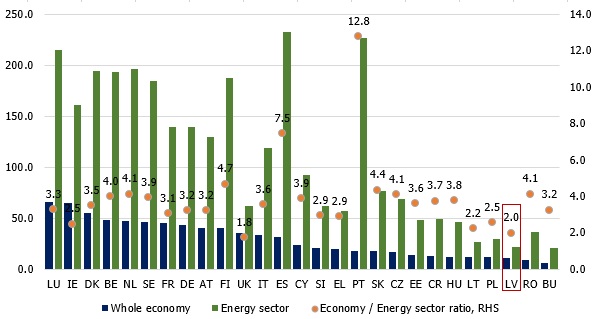Analytics, Banks, Direct Speech, Energy, Latvia
International Internet Magazine. Baltic States news & analytics
Thursday, 18.04.2024, 05:42
Latvia’s energy sector: challenges and prospects
 Print version
Print version |
|---|
Despite having grown over time and remaining twice as productive as the economy on average (Figure 1), Latvia's energy sector growth has decoupled from overall economic growth and the sector has gradually lost its share in GDP over the recent decades.
Figure 1. Productivity, EUR per hour worked.

The structural changes in the economy as well as improved energy-efficiency could be mentioned among the reasons.
Nevertheless, the value-added created in the economy by using an equivalent energy unit has increased.
One of the most obvious medium-term challenges for Latvia's energy sector is the limited scope for increase in demand given the energy-efficiency goals (for instance, Latvia's residential sector has a large room for improvement here), shrinking population as well as the lack of large-scale projects that would be associated with sizable energy consumption. Insufficient demand in a number of areas in Latvia (for instance, in water supply) manifests itself in the fixed components of energy bills as the costs of infrastructure need to be shared by a smaller number of consumers and limited consumption. The Eurostat data on energy prices suggest that a slight tendency to shift the burden of an increase in unit price of electrical energy to households rather than to industrial consumers has been evident across the EU since 2010.
Liberalised markets, better developed infrastructure and deeper regional integration provide an access to a larger market, at the same time aggravating rivalry. It means that energy production costs remain among the key issues when aiming for higher shares of energy produced from renewables as well as designing support mechanisms for renewable energy producers.








 «The Baltic Course» Is Sold and Stays in Business!
«The Baltic Course» Is Sold and Stays in Business!

